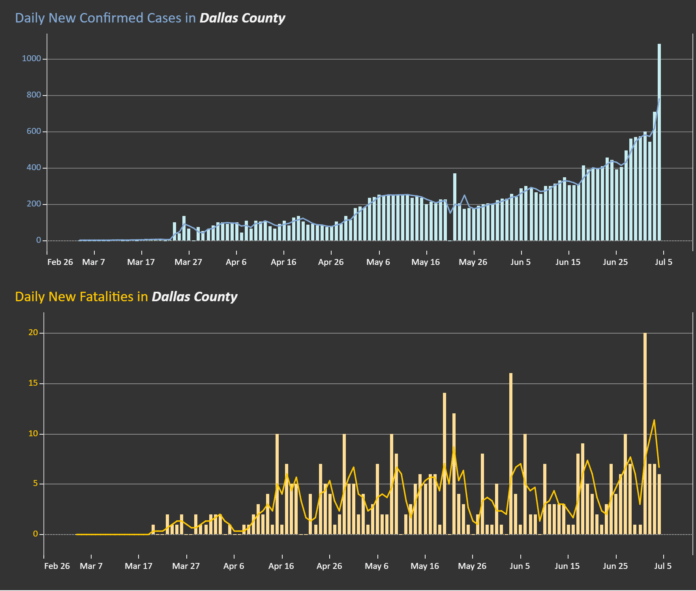Dallas County COVID-19 Cases Continue to Rise
DALLAS — Yesterday was the first time Dallas County reported more than 1,000 new COVID-19 cases in one day. Today, Dallas County Health and Human Services reports 1,103 additional positive cases of 2019 novel coronavirus (COVID-19), bringing the total case count in Dallas County to 24,778, including 395 deaths.
The additional 2 deaths being reported today include:
- A man in his 70’s who was a resident of the City of Balch Springs. He expired in an area hospital, and had underlying high risk health conditions.
- A woman in her 80’s who was a resident of a long-term care facility in the City of Dallas. She expired at home, and had no known underlying high risk health conditions.
“Today we reached 1,100 new cases for the first time. It took us 92 days to reach 300 cases, 22 days to reach the next 400 more cases at 700 cases and 2 days to reach another 400 cases at 1,100. I appreciate the spirit of the people of North Texas, that they have moved from our understandable selfish desire to enjoy our 4th of July traditions to being sacrificial and keeping their celebrations to their household only. This is necessary because of the out-of-control spread that we are now experiencing with COVID-19.
Jenkins Continue To Push For Certain Types of Businesses To Close
I strongly urge everyone to go www.DallasCountyCOVID.org and download the colored coded chart as to what is safe and not safe as prepared by local health experts. Eight days ago I sent Governor Abbott a letter with a list of requests from local health leaders for action to control the spread of COVID-19. While the Governor did move to a statewide masking mandate and addressed crowd size at the request of 10 people, there are still matters left to address in the letter, such as the pausing of select businesses where masks cannot be worn 100% of the time.
I urge the Governor to reconsider these medical requests and everyone to avoid the places on the attached letter as if they were closed during this time of rampant spread. I hope everyone is having a good 4th of July weekend. This 4th of July is different but I hope that it is rewarding for you and your family,” said Dallas County Judge Clay Jenkins.
All Dallas County COVID-19 Updates and Information can be found here: https://www.dallascounty.org/covid-19/
Over 50% Of New Cases Since June 1 Are In Adults 18-39
An increasing proportion of COVID-19 cases in Dallas County are being diagnosed in young adults between 18 to 39 years of age, such that of all cases reported after June 1st, half have been in this age group. Increasing reports of cases are continuing to be associated with multiple large recreational and social gatherings since the beginning of June, including house parties.
Of the almost 3,000 cases requiring hospitalization to date, more than two-thirds have been under 65 years of age, and about half do not have any high-risk chronic health conditions. Diabetes has been an underlying high-risk health condition reported in about a third of all hospitalized patients with COVID-19.
The percentage of respiratory specimens testing positive for SARS-CoV-2 increased to 33.7% among symptomatic patients presenting to area hospitals in week 26.
Local health experts use hospitalizations, ICU admissions, and ER visits as three of the key indicators in determining the COVID-19 Risk Level (color-coded risk) and corresponding guidelines for activities during our COVID-19 response. We continue to see high numbers of COVID-19 inpatients in Dallas County with 640 COVID-19 patients in acute care for the period ending Friday, July 3.
Additionally, the number of emergency room visits for COVID-19 like symptoms in Dallas County continues to be high with 731 emergency room visits in the 24 hour period ending Friday, July 3, which represents 34 percent of all emergency department visits in Dallas County according to information reported to the North Central Texas Trauma Regional Advisory Council. These numbers continue to put tremendous strain on our health care facilities and providers.














